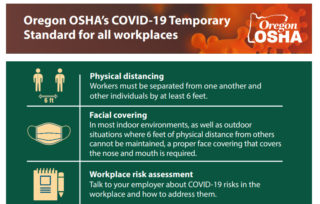Seyfarth Synopsis: Oregon OSHA finalized its COVID-19 temporary rule, OAR 437-001-0744, Addressing COVID-19 Workplace Risks, on November 6, 2020, with most provisions effective as of November 16, 2020; the rule sunsets on May 4, 2021. The temporary rule applies to all workplaces and includes additional requirements for workplaces with exceptional risk. Oregon OSHA also included a series of mandatory, industry-specific directives.

Oregon OSHA's temporary rule includes a number of anticipated requirements for all employers, such as: physical distancing; masks, face coverings, or face shields; cleaning and sanitation; posting signage; notifying exposed and affected employees; cooperating when a public health agency indicates that testing in the workplace is necessary; removing affected workers; allowing affected workers to perform their duties remotely; returning quarantined or isolated workers to return to work without adverse action; and making return to work decisions based on public health and medical provider guidance.
No later than November 23, 2020, building operators must ensure the standard's sanitation requirements are met and post signs where masks are required; and no later than January 6, 2021, employers must optimize the amount of outside air circulated through existing HVAC systems.
Some of the heavier, more specific lifts required by Oregon's emergency rule include:
- Exposure Risk Assessment: No later than December 7, 2020, employers must conduct a COVID-19 exposure risk assessment, without regard to the use of PPE, masks, face coverings, or face shields.
- Infection Control Plan: No later than December 7, 2020, employers must establish and implement an infection control plan based on identified risks. The plan must contain:
- A list of all assignments or tasks requiring the use of PPE (including respirators);
- Procedures to ensure an adequate supply of masks, face coverings, or face shields, and PPE (including respirators);
- A list of specific hazard control measures that the employer installed, implemented, or developed;
- A description of the employer's COVID-19 mask, face covering, and face shield requirements;
- Notification procedures regarding an employee's COVID-19 exposure, including to individuals identified through contact tracing and the workplace at large; and
- Procedures to provide workers with required information and training.
- Employee Information and Training: No later than December 21, 2020, employers must provide information and training in a manner and language understood by the affected workers, and must allow for employee feedback. Training must include:
- Physical distancing requirements;
- Mask, face covering, or face shield requirements;
- Sanitation requirements;
- Infection signs and symptom reporting procedures;
- Infection notification processes;
- Medical removal;
- Characteristics and methods of transmission;
- Symptoms of COVID-19;
- The ability of pre-symptomatic and asymptomatic COVID-19 persons to transmit the virus; and
- Safe and healthy work practices and control measures.
Mandatory Appendix A provides industry-specific directives for 19 different industries.
Additional requirements apply to workplaces at exceptional risk, e.g., those involved in direct patient care, environmental decontamination services in a healthcare settings and aerosol-generating healthcare or postmortem procedures, among many others. The additional requirements address infection control training and plans; sanitation; healthcare PPE; ventilation systems; and, in healthcare settings, barriers, partitions, and airborne infection isolation rooms, screening, and medical removal provisions.
The content of this article is intended to provide a general guide to the subject matter. Specialist advice should be sought about your specific circumstances.





